|
Oct
13
2025
|
|
Posted 63 days ago ago by Admin
|
|
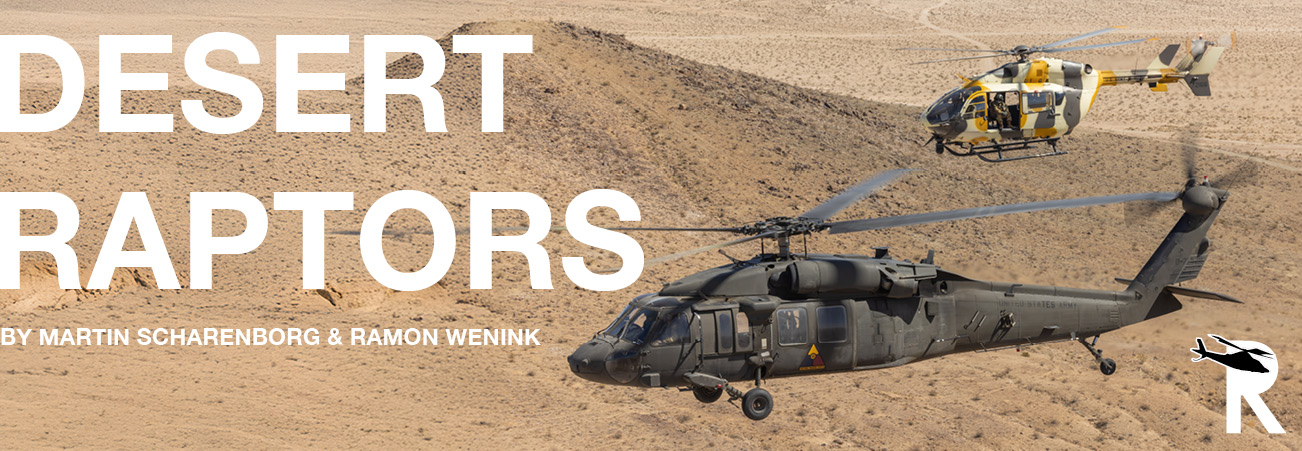
The 2916th Aviation Battalion ‘Raptors’ at the United States Army National Training Center play a vital role in preparing combat units for tomorrow’s fight.
Located in San Bernardino County, California, and surrounded by the hills of the Mojave Desert, the National Training Center at Fort Irwin is one of the largest training areas in the U.S. Measuring roughly 1,000 square miles, the area has the approximate acreage of Rhode Island. The harsh environment with high temperatures, occasional strong winds, and rugged terrain makes this area the ideal setting for training Armored Brigade Combat Teams and units from other services and allies.
This National Training Center at Ft. Irwin was established in 1979. Annually, approximately 10 Rotational Training Units (RTUs) with between 50,000 and 60,000 soldiers and their equipment pass through Ft. Irwin to train in the most realistic combat scenarios possible.
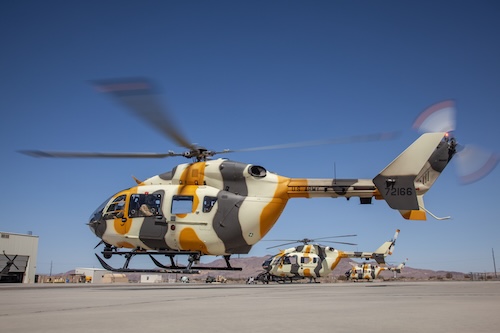
From 2011the UH-72A Lakota was introduced with B-Company and is currently operating five aircraft out of nearby Barstow-Daggett Airport. The aircraft are all painted in the ‘Bruised Banana’ color scheme and fitted with laser-sensors for the improved MILES-system on the skids and on the fuselage.
Opposing Forces
Serving as the Opposing Force (OPFOR) for the Rotational Training Units is the 11th Armored Cavalry Regiment ‘Black Horse.’ The unit joined the NTC at Fort Irwin in 1994 and is specialized in enemy warfare and uses tactics and equipment that the enemy would use in modern warfare. Humvees and M113 vehicles are heavily modified to replicate Russian T-72, T-90, BMP-2 and BMP-3 tanks to serve as OPFOR Surrogate Vehicles (OSVs). Also, several villages (mock cities) have been built in the vast desert to replicate enemy strongholds to train urban warfare.
The accomplishments and progress of the RTUs are closely monitored by the Operations Group’s Observer, Coach and Trainer teams (OC/OCT).
Sokol
To assist the 11th ACR, the 2916th Aviation Battalion ‘Raptors’ play an important role. The Battalion reports to the 916th Support Brigade and consists of three flying companies and a subordinate aviation regiment. Bravo-Company is nicknamed Sokol, which means ‘Falcon’ in Russian, and provides enemy air threat for the RTUs. From 1980 until December 2011 the Bell UH-1H and JUH-1H Huey served at the NTC and with the 2916th Aviation Brigade.
The Hueys were painted in a smart yellow, green and brown color scheme with a bright red star to replicate enemy Mil Mi-24 Hind helicopters. The JUH-1H was additionally fitted with an extended nosecone, replicating an extra cockpit, to make it look even more like a Mi-24. The aircraft were fitted with the Multiple Integrated Laser Engagement System (MILES) on hardpoints on both sides of the fuselage that simulated rockets or guns fired from the helicopter. RTU-units both on the ground and in the air were equipped with laser-receivers that alerted the Observer, Coach and Trainer Teams (OC/OCT) if a vehicle or aircraft was hit and no longer allowed to participate in the day’s exercise.
From 2011, the UH-72A Lakota was introduced with B-Company and is currently operating five aircraft out of nearby Barstow-Daggett Airport. The aircraft are all painted in a ‘bruised banana’ color scheme and fitted with laser-sensors for the improved MILES-system on the skids and on the fuselage. “We are also using the TESS-system (Tactical Engagement Simulator System), which is basically a part of MILES. It is a camera that has an IR-component to it that peers with the MSMODIM (Modular Smart Onboard Digital Interface Device) and the MILES-system that allows us to engage and be engaged by the ground forces . We have some screens on board and with the camera we can zoom in and out, acquire a target and fire a laser. The forces on the ground, and also our aircraft, have a light on board. When you are hit, this light will start flashing. Our Operations Group are the referees for this fight. They can see everyone moving across the battlefield and they are able to identify which kills occurred. So if Sokol takes out a tank or a vehicle, they might not know what hit them. As soon the light starts flashing, they will stop and then their OC (observer coach) who is with them, receives a message from the referee: You are just killed by an attack-aviation asset! The system also allows the players to see later on what killed them via the assisting Observer Coach/Trainer during the debriefing. For instance, a machine gun, tank or a missile,” explains Chief Warrant Officer 3 (CW3) Luiz Cardona. After having been assigned to different Blackhawk Companies, he became lead instructor pilot at B-Company Sokol.
Challenging Conditions
Sokol uses Russian doctrine that is available on open source and other mediums in order to simulate tactics, but it will also use U.S.-based doctrine because some U.S. doctrine and Russian doctrine will cross-pollinate and be very similar,” says Cardona. “Ultimately though, the specific doctrine will change based on the scenario that they are facing. If the RTU is doing very well , they will ramp it up and the RTU will be facing more complicated maneuvers in a much more aggressive attack profile. For me, it is the most challenging area that I have flown in. The heat is one thing , it reduces aircraft performance, but it can also be very dark out there; it can be extremely windy and the dust is another thing. We have to be very focused on what we do. It also depends where you are. The terrain and the environment is not the same in every single portion of the box (training area). In some areas the sand is much thicker and so when the dust gets kicked up it is almost like rocks hitting the aircraft. Then, you go five miles east or west and you might encounter something I call ‘Moondust.’ You can be 40 feet up in the air and experience complete brown-out. It goes dark and it is daytime!”
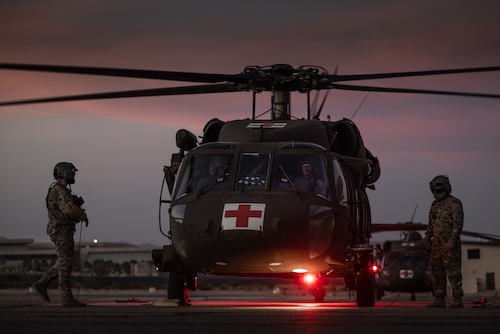
Charlie-Company of the 2916th Aviation Battalion is one of the busiest MEDEVAC-units in the United States. It provides 24/7 365 days a year MEDEVAC-coverage for both the NTC and San Bernardino County.
Desert Hawks
Alpha Company Desert Hawks of the 2916th Aviation Battalion is praised for the broadest mission set. From 2011 until 2015, the unit operated a mix of UH-72As and UH-60s. Today, the unit operates only seven UH-60L Blackhawk helicopters out of Barstow-Daggett Airport. The main task of the unit is the VIP-transport mission. On a regular basis, the NTC at Fort Irwin is visited by civic leaders, commanders, generals, celebrities, congressional delegates and foreign dignitaries. Over the years, tasks were expanded to include aerial reconnaissance (Aerial RECON), re-supply missions (Jingle-Air), CASEVAC, but also air assault missions for the 11th ACR.
“Because the A-Company’s UH-60Ls do not have MILES, when they are participating in the game, they always will be accompanied by a B-Company UH-72A. Between rotations, the Tarantula OCT (part of the NTC OPS Group) is on airborne status and has to jump every so often, A-Company will conduct all their airborne operations and do para-drops. They are the Swiss-army knife of operations here,” says Captain Robert B. Forney, former commander of A-Company and current S3 operations officer at the 2916th Aviation Battalion.
Desert Dustoff
Where there is intensive training, accidents are bound to happen. Charlie-Company of the 2916th Aviation Battalion is the unit that provides Aeromedical Evacuation (MEDEVAC). The unit currently operates six UH-60L Blackhawks that replaced, in 2015, the UH-60A+ nicknamed the Frankenhawk. “Actually, this was the perfect helicopter to operate in this environment. It had the lighter airframe of the A-model, but was fitted with the more powerful engine of the L-model. It gave us more power to operate in hot-and-high conditions. We also operated until 2015 the UH-72A Lakota, but this aircraft was not meeting our expectations as it was limited in performance. Therefore, it could happen that sometimes we had to leave a crew member or heavy equipment behind. With the UH-60L Blackhawk, we do not have that problem,” explains Major Michael Chase, commander of C-Company Staff. Sergeant Derek Randall, C-Company flight medic with over 400 flying hours and 60 real missions adds, “We are the busiest Dustoff unit! We are the first responder for the RTUs, and the second responder for Southern California. Additionally, we do a lot for the community. I have almost transferred anything; from a little kid to someone’s grandma, and on top of that, we proviode local support for San Bernardino County. One of our most memorable missions occurred on 4 October 2021, when a F/A-18F, operating out of China-Lake, suffered an engine failure and the pilot had to bail out. Our crews responded as the nearest MEDEVAC unit. The Medic jumped out of the helicopter at the crash site and found the pilot who had some head trauma and he got checked out at the hospital. For me personally, the most memorable mission was when a child fell down some stairs and had a shifting inter-cranial bleed. We took him to the hospital, and the next week I saw him back when his parents brought him to the airfield and he was all happy. That’s what makes it worthwhile for me: all the positive turnarounds.”
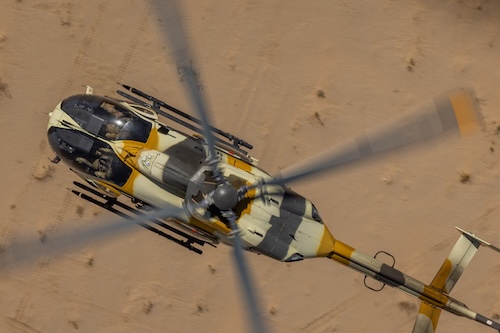
Flying Tigers
The only deployable unit from the 2916th Aviation Battalion is B. Company, 229th Aviation Regiment. Since 2014, the unit has operated the General Atomics MQ-1C Gray UAS out of Goldstone Airport on NASA's Deep Space Communications Complex in the Ft. Irwin Area. Its mission is to provide unmanned reconnaissance, surveillance, targeting and acquisition. The unit returned in November 2021 from a long deployment in the Persian Gulf area (Kuwait and Iraq) in support of Operation Inherent Resolve, having flown over 15,000 hours during 900+ missions.
B. Company 229th Aviation Regiment normally supports the NTC’s visiting RTUs in MUM-T (manned un-manned teaming) and provides reconnaissance and surveillance in order to detect hostile encounters in an early stage. The U.S. Army is currently introducing the MQ-1C ER (extended range) in her Gray Eagle units.
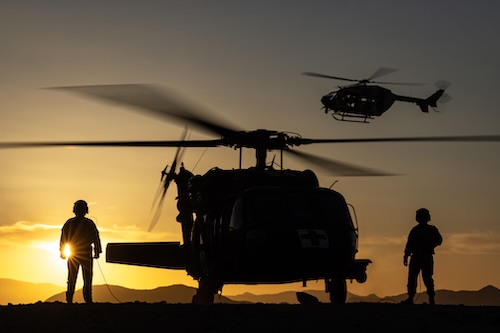
Lessons Learned
With over 2,100 flying hours and having served, amongst other assignments, with the 3rd Combat Aviation Brigade, 82nd Airborne Division and at the National Airborne Operations Center (NAOC) at Offut AFB, Lieutenant Colonel Daniel C. Morris became commander of the 2916th Aviation Battalion in 2020. He says, “With the eye on the events currently going on in Nagorno-Karabach and between Russia and Ukraine and the tactics and doctrines used, the NTC’s vision is aiming on replicating the first fight of the next war and making sure that the units that are coming here to train have their toughest days here. Their toughest fight that they are going to have is going to be here at the NTC. There is so much to focus on than just aviation. It is easy not to focus on the tactics when you are just trying to keep the aircraft in the air and keep everyone safe and flying, but when you leave here, you are sort of deeply involved in doctrine and tactics. That’s my hope and that is kind of my vision. On its face, Ft. Irwin doesn’t exactly look like an oasis, but in terms of aviator capability that you build here, it is impactful and we have already had people ask to come here and say, ‘I am going to come here and fly in a tougher environment twice as much as peers in other units and do a broader selection of missions.’ That is how we draw talent here. Our people leave here as the utility-knife aviators of the Army, and my hope is that they go out to their aviation brigades and share their experience with the units they fly with now and with those that they will be flying with in the future.”

The authors would like to thank the 2916th Aviation Brigade and the NTC at Fort Irwin for their hospitality and their kind cooperation while compiling this article.
READ JUL/AUG ISSUE OF ROTOR PRO
READ MORE ROTOR PRO: https://justhelicopters.com/Magazine
WATCH ROTOR PRO YOUTUBE CHANNEL: https://buff.ly/3Md0T3y
You can also find us on
Instagram - https://www.instagram.com/rotorpro1
Facebook - https://www.facebook.com/rotorpro1
Twitter - https://twitter.com/justhelicopters
LinkedIn - https://www.linkedin.com/company/rotorpro1